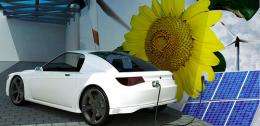Different energy mixes will fuel plug-in hybrid cars

Few drivers know exactly which well in which country their gasoline comes from, and from an environmental standpoint, it may not matter. Burning petroleum from the United States, Canada, Russia or Iran would each release large amounts of harmful greenhouse gases into the atmosphere.
However, the blossoming development of market-ready plug-in hybrid electric vehicles (PHEVs) will change this calculation. Unlike petroleum, which comes almost uniformly from drilled wells, the electricity to be consumed by PHEVs originates in a number of different natural resources: in the form of renewables such as wind and solar energy and non-renewables like coal and natural gas.
The manufacturing process for each of these different sources of electricity results in different quantities of greenhouse gas emissions, and therefore each has a markedly different impact on the environment. Scientists at the U.S. Department of Energy’s Argonne National Laboratory have begun to examine the precise effect of this new portfolio of different fuel sources for plug-in vehicles on our environment.
Led by engineers Michael Wang and Amgad Elgowainy, the Argonne team expanded and used the laboratory’s Greenhouse Gases, Regulated Emissions and Energy Use in Transportation (GREET) model to assess which types of power plants are likely to generate the electricity used by PHEVs in different regions of the United States. Although hybrids of all stripes emit fewer greenhouse gases - and are therefore more environmentally friendly - than conventional gasoline-powered vehicles, the Argonne model shows a remarkable result for plug-in hybrid vehicles.
Although the increased demand for electricity by PHEVs is small relative to the quantity of electricity we already consume, this increased demand could produce very different greenhouse gas effects in each region of the country. PHEV drivers in Illinois, for instance, would likely charge their vehicles with coal-generated power, while in the Northeast or California the same vehicle would be supplied by plants that burn cleaner natural gas.
“The development and production of more plug-in hybrid vehicles will definitely help ease America’s dependence on foreign oil and improve our national security,” said Elgowainy. “It’s important that we also address how they will change the amount of greenhouse-gas emissions coming from the transportation sector.”
The Argonne researchers also looked at how different patterns of behavior for charging these hybrids would impact the total demand on the grid. In developing their first model, they assumed that PHEV owners would likely charge their vehicles overnight, when they won’t be driving and energy is cheapest. Under this paradigm, more and more fossil-based power plants are brought online to handle the additional demand represented by vehicle charging. For regions with a large share of coal-power generation, the electricity generated for recharging PHEVs could result in greenhouse gas emissions comparable to conventional gasoline-powered vehicles.
However, the researchers also considered a different case - one in which many drivers chose to charge their batteries in the middle of the day. In this scenario, the additional electricity would likely originate in different power plants such as natural gas plants - which would result in less greenhouse gas emissions, comparable to grid-independent hybrid vehicles, which generate electricity from the act of braking. “The decision to plug in a hybrid at a different time of the day could change the energy resource used to power it,” Wang said. “Ultimately, this could alter the economic and environmental effects of owning a plug-in hybrid.”
As the United States pursues the transformation of its energy portfolio from one based overwhelmingly on fossil fuels to one that relies on renewable power sources, PHEVs will, in turn, become increasingly environmentally friendly. “As we electrify America’s transportation infrastructure, we must also strive to find cleaner sources of energy to supply the increased demand,” Wang said.
Provided by Argonne National Laboratory
















